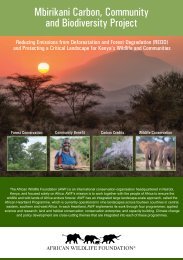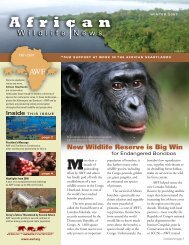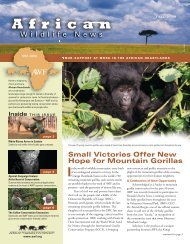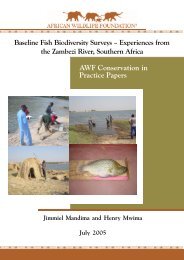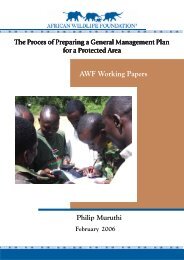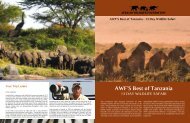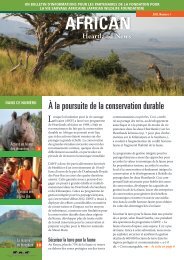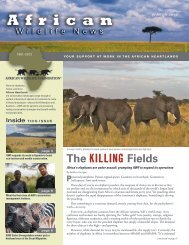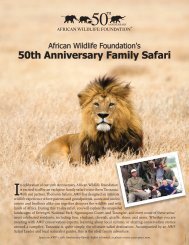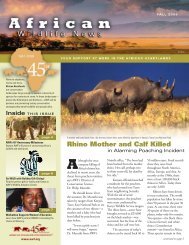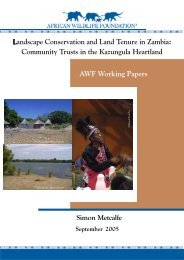New Visitor Center - African Wildlife Foundation
New Visitor Center - African Wildlife Foundation
New Visitor Center - African Wildlife Foundation
- No tags were found...
Create successful ePaper yourself
Turn your PDF publications into a flip-book with our unique Google optimized e-Paper software.
4 <strong>African</strong> <strong>Wildlife</strong> <strong>New</strong>sSafari Report FROM CRAIG SHOLLEYAWF Members ShareExperience of a LifetimeWhile Gorilla TrekkingJulia Wasserman has been amember of AWF for more than20 years. She serves as aState Representative in theConnecticut legislature.Julia took part in AWF’s safarito Rwanda and Uganda this pastOct-ober. Thirty-five years ago,Julia and her husband visitedUganda and had fond memoriesof their time there.So, when Julia read anarticle in Nature’s BestMagazine about the safari,she decided to go. Shesaid, “I’ve always wantedto see the gorillas.”Julia highly recommendstaking a safaribecause it allows AWFmembers to see exactlyhow their support ismaking a difference forthe wildlife and theirhabitat.Her top three highlightswere “the incrediblebeauty of the countries,the gorillas, andthe guides – they werefantastic, extremelyfriendly.”Eight AWF members are joined by their safari guides.Safari — Through theEyes of One MemberCraig R. SholleyJulia was so inspired by hersafari experience that she hasbecome a Founding Member of ourMountain Gorilla Conservation Trust.This major donor giving programfunds the International GorillaConser-vation Program (IGCP) andAWF’s work to support it – protectingone of the world’s rarest apesand the land they call home.Craig R. SholleyEvery time I return to Uganda and Rwanda, itfeels like a homecoming. And on AWF’s recentOctober safari to these beautiful countries, Iwas able to share the emotion of homecoming witheight AWF members.The focus of our safari was gorillas, but we alsovisited wildlife areas in vivid contrast to Bwindi’s ImpenetrableForest and the Virunga Mountains. Theseincluded Kibale and Queen Elizabeth National Parks(QENP).In Kibale, the forests provide primate wondersfound few other places in the world. Observations inKibale included a mixed troop of 50 red colobus and redtailedmonkeys feeding peacefully on fruit high abovethe forest floor. Elsewhere, small groups of black andwhite colobus were seen regularly, as were large troopsof olive baboon and the occasional grey-cheekedmangabey.The highlight of Kibale was Uganda’s other greatape – the common chimpanzee. In a giant fig treestretching 150 feet upwards, we discovered 20 or morechimpanzees feeding frantically on figs. They expressedtheir delight intermittently with pant-hoots, whichresounded throughout the forest.It is nearly impossible to describe how loud excitedchimpanzees can be – suffice it to say the AWF group ofHomo sapien cousins craning necks below erupted inlaughter and smiles each time a new chimp discoursetook place.Continuing to QENP, the terrain changed dramatically.Ancient volcanic craters dot the landscape of oneof the continent’s most beautiful grassland ecosystems.QENP is home to the largest concentrations of Nilehippo, and a launch trip on the Channel placed ourgroup in the midst of large hippo schools.Elephants, buffalo, waterbuck, warthog, andUganda kob drank or wallowed at the water’s edge. Abounty of birdlife, ranging from the diminutive malachitekingfisher to the striking saddle-billed stork and greatwhite pelican, adorned the shoreline.Elsewhere in the park, we spent the morning withtwo lionesses and five six-month-old cubs as theylounged lazily, recovering from gorging themselves onan old male kob taken the evening before.Gorilla trekking is always intimidating, and I smileas a group’s excitement grows the evening before theircontinued on page 5



